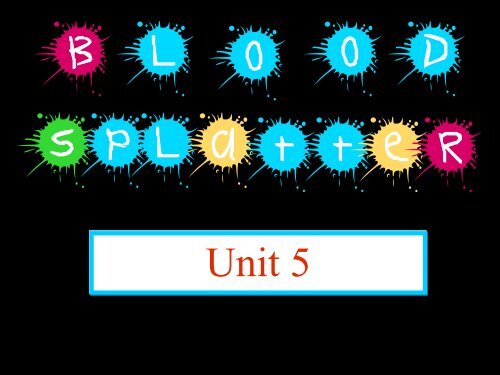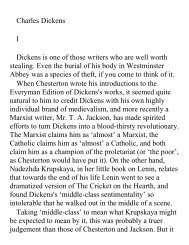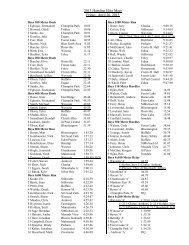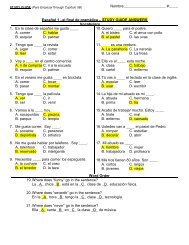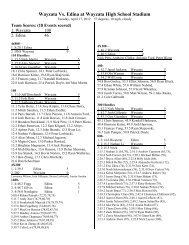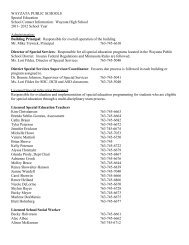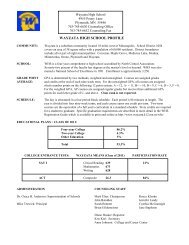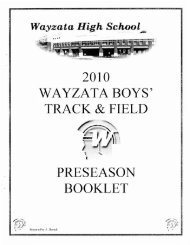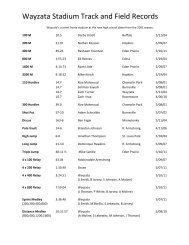Blood Spatter
Blood Spatter
Blood Spatter
Create successful ePaper yourself
Turn your PDF publications into a flip-book with our unique Google optimized e-Paper software.
Unit 5
1<br />
<strong>Blood</strong>stain Evidence<br />
May reveal:<br />
• Origin(s) of bloodstain<br />
• Distance of bloodstain from target<br />
• Direction from which blood impacted<br />
• Speed with which blood left its source<br />
• Position of victim & assailant<br />
• Movement of victim & assailant<br />
• Number of blows/shots
2<br />
• Physical properties<br />
– viscosity<br />
– surface tension<br />
– Density<br />
Liquid <strong>Blood</strong>
3<br />
Surface Tension<br />
• Resistance to penetration & separation<br />
• Surface tension acts to reduce surface area<br />
• Smallest SA to Volume ratio is offered<br />
by sphere
4<br />
Dripping <strong>Blood</strong><br />
<strong>Blood</strong> trickles downwards<br />
<strong>Blood</strong> drops grow until Wt (G) > S.T.<br />
Single drop breaks free (teardrop shape)<br />
Surface tension pulls in vertically<br />
And horizontally<br />
Shape settles into sphere (0.05 ml)<br />
Does not break up until impact
9<br />
Shape & Size of <strong>Blood</strong>spot<br />
• Depends mostly on nature of target surface<br />
– texture (rough or smooth)<br />
– porous or non porous<br />
• Size is related to distance fallen, provided:<br />
– standard 50 ul drop of blood<br />
• There is little change in spot diameter<br />
beyond a fall distance of 1.2 m or 7 ft.
10<br />
Height Fallen<br />
Single drops of blood falling from fingertip onto<br />
smooth cardboard from various heights.<br />
No change in diameter beyond 7 ft.<br />
Adapted from<br />
Introduction to Forensic Sciences,<br />
W. Eckert, CRC, 1997
4 Phases of Impact<br />
• Contact and Collapse<br />
• Displacement<br />
• Dispersion<br />
• Retraction
Categories of <strong>Blood</strong> Stain Analysis<br />
• Passive<br />
• Projected<br />
• Transferred
TRANSFER BLOODSTAINS<br />
• A transfer bloodstain is created when a<br />
wet, bloody surface comes in contact with<br />
a secondary surface.<br />
• A recognizable image of all or a portion<br />
of the original surface may be observed<br />
in the pattern.<br />
• Examples: bloody hand or footwear.
68<br />
Transfer Patterns<br />
• Wet, bloodied object contacts a secondary<br />
surface<br />
• Transfer from:<br />
– hand, fingers<br />
– shoes, weapon<br />
– hair<br />
• Transfer to:<br />
– walls, ceilings<br />
– clothing, bedding<br />
• Produces mirror-image of bloodied object
Transfer from hair<br />
(hair-swipe) 1<br />
69
Transfer from hair<br />
(hair-swipe) 2<br />
70
PASSIVE BLOODSTAINS<br />
• Passive <strong>Blood</strong>stains are drops created or<br />
formed by the force of gravity acting<br />
alone.
PROJECTED BLOODSTAINS<br />
• Projected bloodstains are created when<br />
an exposed blood source is subjected to<br />
an action or force, greater than the force<br />
of gravity.<br />
• The size, shape, and number of resulting<br />
stains will depend, primarily, on the<br />
amount of force utilized to strike the<br />
blood source.
This category can be further<br />
subdivided to include;<br />
• Arterial Spurt / Gush<br />
– <strong>Blood</strong>stain pattern(s) resulting from blood<br />
exiting the body under pressure from a<br />
breached artery:
50<br />
Arterial Spurt Pattern<br />
• <strong>Blood</strong> exiting body under arterial pressure<br />
• Large stains with downward flow on<br />
vertical surfaces<br />
• wave-form of pulsatile flow may be<br />
apparent
51<br />
Small arterial spurt<br />
spatter<br />
broken pottery
52<br />
Neck incisions (scene)
53<br />
Neck incisions<br />
‘Hesitation’ injuries<br />
Probe in carotid artery<br />
Thyroid cartilage
This category can be further<br />
subdivided to include;<br />
• Cast-off Stains<br />
– <strong>Blood</strong> released or thrown from a bloodbearing<br />
object in motion:
This category can be further<br />
subdivided to include;<br />
• Impact <strong>Spatter</strong><br />
– <strong>Blood</strong> stain patterns created when a blood<br />
source receives a blow or force resulting in<br />
the random dispersion of smaller drops of<br />
blood.
This category can be further<br />
subdivided into<br />
• Low Velocity…up to 5 feet/sec.<br />
– Relatively large stains<br />
– 4mm in size and greater
This category can be further<br />
subdivided into<br />
• Medium Velocity<br />
– Force of 5 to 25 feet/sec.<br />
– Preponderant stain size 1 to 4mm in size<br />
• High Velocity<br />
– Force of 100 feet/sec. and greater<br />
– Preponderant stain size 1mm in size and<br />
smaller<br />
– Mist like appearance
High Velocity: Gun
20<br />
<strong>Blood</strong> <strong>Spatter</strong><br />
• Low velocity (5 f/s, 1.5 m/s)<br />
– e.g. free-falling drops, cast off from weapon<br />
• Medium velocity (25 - 100 f/s, 7.5 - 30 m/s)<br />
– e.g. baseball bat blows<br />
• High velocity (>100 f/s, 30 m/s)<br />
– e.g. gunshot, machinery
22<br />
Low Velocity <strong>Blood</strong> <strong>Spatter</strong><br />
• <strong>Blood</strong> source subjected to LV impact<br />
– < 5 f/s (1.5 m/s)<br />
• Spot diameter: mostly 4 - 8 mm<br />
– some smaller, some larger<br />
• Free-falling drops (gravity only)<br />
• Cast off from fist, shoe, weapon<br />
• Dripping<br />
• Splashing<br />
• Arterial spurting
11<br />
Effect of Target Surface<br />
. . .<br />
Spreads out smoothly ST of spreading edge is<br />
broken by irregular surface
13<br />
0.5<br />
1<br />
2<br />
3<br />
Single drop of blood falling from various heights (m) onto various surfaces<br />
Height/Surface<br />
smooth floor paper towel fabric<br />
0.5<br />
1<br />
2<br />
3
14<br />
Angle of<br />
Impact<br />
Gravitational dense zone<br />
at lower edge<br />
Adapted from<br />
Introduction to Forensic Sciences,<br />
W. Eckert, CRC, 1997<br />
90<br />
30<br />
80<br />
20<br />
70<br />
60 50 40<br />
10
David Sadler:<br />
15<br />
Wave Cast-off<br />
.<br />
Tail of elongated stain<br />
points in direction of travel<br />
Tail of wave cast-off points<br />
back to parent drop<br />
Parent drop<br />
wave cast-off
16<br />
Point of Convergence
17<br />
5 ml blood squirted from a<br />
syringe from height of 1 m<br />
Point of Convergence
18 1<br />
Height above point of convergence<br />
Point of Origin<br />
Origin<br />
length<br />
width<br />
Angle of impact = arc sin W/L<br />
85 60 45 30<br />
Distance from point of convergence
19<br />
Tracing Origin of<br />
<strong>Blood</strong>spots<br />
• Point of convergence method<br />
– 2 dimensional image<br />
• Point of origin method<br />
– adds 3rd dimension to image<br />
• In practice:<br />
– use of string & protractor at scene<br />
– use of computer at laboratory
Herbert Leon MacDonell,<br />
Laboratory of Forensic Science,<br />
P.O. Box 1111,<br />
Corning,<br />
New York,<br />
14830,<br />
USA<br />
21
23<br />
Cast-off from Weapon<br />
• First blow causes bleeding<br />
• Subsequent blows contaminate weapon with<br />
blood<br />
• <strong>Blood</strong> is cast-off tangientially to arc of upswing<br />
or backswing<br />
• Pattern & intensity depends on:<br />
– type of weapon<br />
– amount of blood adhering to weapon<br />
– length of arc
24<br />
Downswing of Hammer
25<br />
ceiling<br />
Cast-off from Weapon
26<br />
Overhead swing with bloodied metal bar
27<br />
Cast-off Pattern (1/2)
28<br />
Cast off Pattern (2/2) 1<br />
2<br />
3
29<br />
Cast off Pattern (2/2)<br />
? Sequence
30<br />
Cast off Pattern (2/2)<br />
? Sequence 1<br />
(4 spots)<br />
2<br />
(3 spots)<br />
3<br />
(2 spots)<br />
If weapon does not pick up more blood, spatter from subsequent<br />
backswings becomes progressively less.<br />
In practice weapon picks up more blood with each successful blow.
31<br />
Three overhead swings with hatchet
32<br />
Cast-off & medium velocity spatter
33<br />
Cast-off & medium velocity spatter 2
34<br />
Cast-off Pattern<br />
? Object
35<br />
Cast-off Pattern<br />
from Hand
36<br />
Cast-off pattern from bloodied hand swung in front of target<br />
6” ruler
37<br />
. . . .<br />
. .<br />
Drip Pattern<br />
• Free-falling drops dripping into wet blood<br />
• Large irregular central stain<br />
• Small round & oval satellite stains<br />
.<br />
. .<br />
.<br />
. .<br />
.<br />
.<br />
. .<br />
.
38<br />
Drip 1:<br />
<strong>Blood</strong> dripping into itself from height of 1 m (8 drops)
<strong>Blood</strong> dripping into itself from height of 1 m (8 drops)<br />
39<br />
Drip 2
40<br />
Dripping onto steps
41<br />
• Volume > 1 ml<br />
Splash Pattern<br />
– Subjected to LV impact<br />
– Thrown<br />
– Tipped<br />
• Large central irregular area surrounded<br />
by elongated peripheral spatter pattern
42<br />
Splash 1<br />
5 ml blood squirted from a syringe from a height of 1 m
5 ml blood squirted from a<br />
syringe from a height of 1 m<br />
43<br />
Splash 2
44<br />
5 ml blood squirted from a syringe from a height of 1 m<br />
Splash 3
45<br />
Splash onto vertical surface<br />
10 ml blood thrown 1 m onto<br />
a vertical target surface<br />
6” ruler
46<br />
Stamping in blood 1<br />
Area seen in close-up<br />
in next slide
47<br />
Stamping in blood<br />
Close-up of heel area
48<br />
<strong>Blood</strong> pool (10 drops) before stamping<br />
Stamp 1
49<br />
<strong>Blood</strong> pool (10 drops) after stamping<br />
Stamp 2
50<br />
Arterial Spurt Pattern<br />
• <strong>Blood</strong> exiting body under arterial pressure<br />
• Large stains with downward flow on<br />
vertical surfaces<br />
• wave-form of pulsatile flow may be<br />
apparent
51<br />
Small arterial spurt<br />
spatter<br />
broken pottery
52<br />
Neck incisions (scene)
53<br />
Neck incisions<br />
‘Hesitation’ injuries<br />
Probe in carotid artery<br />
Thyroid cartilage
54<br />
Medium Velocity<br />
<strong>Blood</strong> <strong>Spatter</strong><br />
• <strong>Blood</strong> source subjected to MV impact<br />
– (25 - 100 f/s, 7.5 - 30 m/s)<br />
• Spot diameter: mostly 1 - 4 mm<br />
• Blows with weapon (e.g. baseball bat)
55<br />
Medium velocity blood spatter.<br />
Point of impact 15 cm in front of vertical target surface<br />
6” ruler
<strong>Blood</strong> flicked between<br />
middle finger & thumb<br />
onto a vertical smooth surface<br />
from a distance of 15 cm<br />
56<br />
Flick 1:
<strong>Blood</strong> flicked between<br />
middle finger & thumb<br />
onto a vertical smooth surface<br />
from a distance of 15 cm<br />
57<br />
Flick 2:
58<br />
High Velocity <strong>Blood</strong> <strong>Spatter</strong><br />
• <strong>Blood</strong> source subjected to HV impact<br />
– > 100 f/s, 30 m/s<br />
• Fine mist: spot size < 0.1 mm<br />
• Small mass limits spread to 1 m<br />
• !Some larger droplets reach further<br />
• Gunshot<br />
– back-spatter from entry wound<br />
– forward spatter from exit wound<br />
• High speed machinery
Gunshot: back& forward spatter<br />
<strong>Blood</strong>stained foam held just above target surface.<br />
Bullet passing L to R just above sheet<br />
bullet<br />
Bullet enters<br />
foam<br />
Back-spatter<br />
on entry<br />
bullet exits foam<br />
Forward spatter<br />
on exit<br />
59
60<br />
Gunshot Back <strong>Spatter</strong><br />
• Arises from entrance wound<br />
• Passes back towards weapon & shooter<br />
• Seen only at close range of fire<br />
• Seen on:<br />
– inside of barrel<br />
– exterior of weapon<br />
– hand, arm, chest of shooter
61<br />
Back spatter<br />
on steadying<br />
hand
62<br />
Gunshot Forward <strong>Spatter</strong><br />
• Arises from exit wound<br />
• Passes forwards in same direction as shot<br />
• More copious than back-spatter<br />
• Can be seen at any range of fire<br />
• Seen on nearby surfaces, objects, persons<br />
– especially on wall behind victim
63<br />
blood soaked<br />
target<br />
Forward spatter (5 ms after bullet impacted at 1000 f/s)<br />
bullet
64<br />
Forward spatter onto target placed 15 cm behind point of<br />
HV bullet impact (bullet passing towards screen) 1<br />
6” ruler
65<br />
Forward spatter (closer view)
5 mm<br />
Forward spatter (closest view)<br />
66
67<br />
Wipe Patterns<br />
• Object moves through a wet bloodstain<br />
• Feathered edge suggests direction
68<br />
Transfer Patterns<br />
• Wet, bloodied object contacts a secondary<br />
surface<br />
• Transfer from:<br />
– hand, fingers<br />
– shoes, weapon<br />
– hair<br />
• Transfer to:<br />
– walls, ceilings<br />
– clothing, bedding<br />
• Produces mirror-image of bloodied object
Transfer from hair<br />
(hair-swipe) 1<br />
69
Transfer from hair<br />
(hair-swipe) 2<br />
70
71<br />
Flow Patterns<br />
• <strong>Blood</strong> flows horizontally & vertically<br />
• Altered by contours, obstacles<br />
• Often ends in pool
72<br />
Flow pattern
73<br />
Trapped!
Stabbing 1<br />
74
75<br />
Stabbing 2
76<br />
<strong>Blood</strong> flow on shirt<br />
Horizontally to R side
77<br />
Pattern on shirt
78<br />
<strong>Blood</strong>spots on trousers


